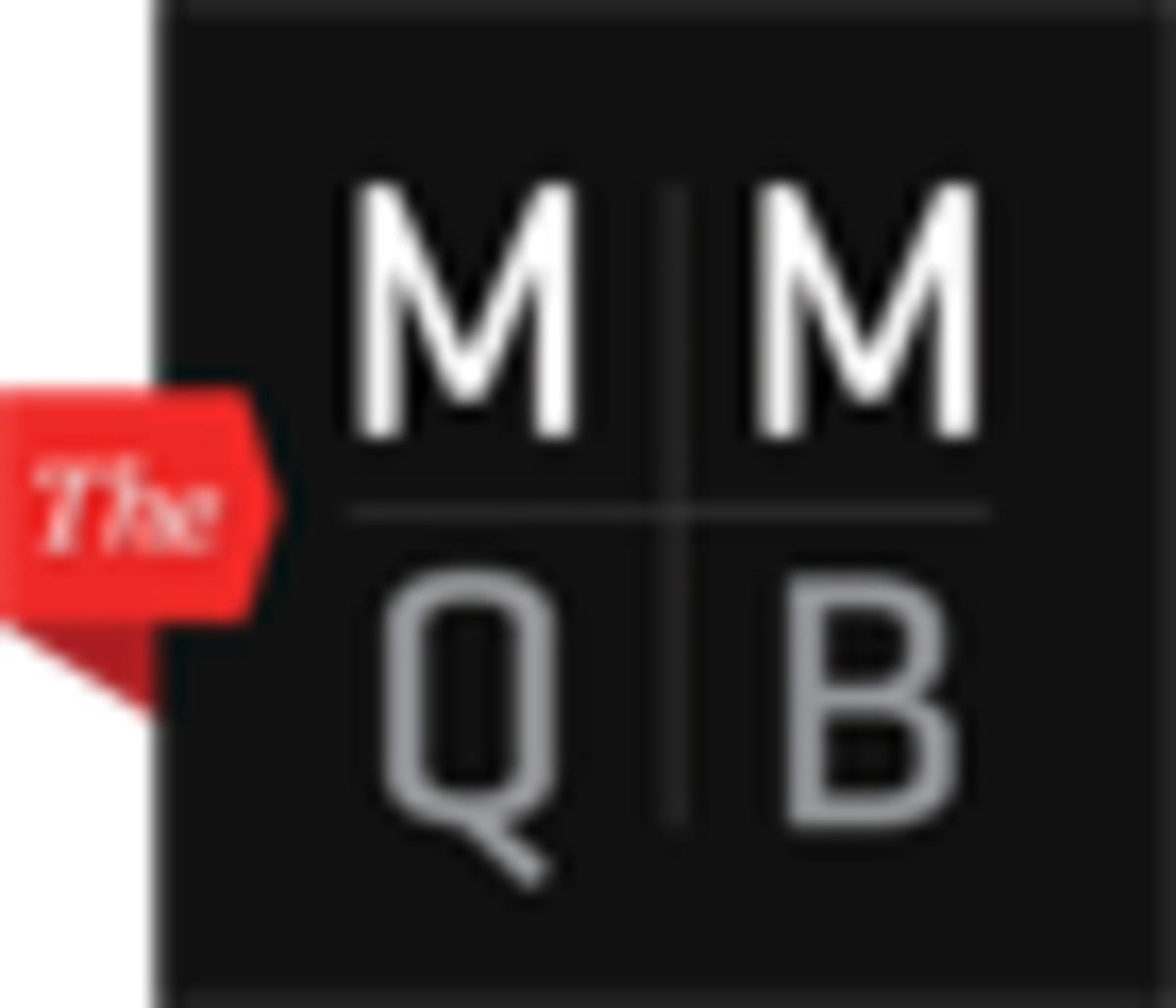The Trainee

A version of this story appears in this week's issue of Sports Illustrated, a special 2015 NFL Draft Preview. To purchase the issue or subscribe to SI, go here.
Michael Bennett wore the black-and-gold shirt and the hat he’d been handed on the field minutes earlier as confetti fell. The Ohio State senior defensive tackle had just gutted out a 42–20 win over Oregon while playing with a groin injury that would have sidelined him for a regular-season game, and capped his college career with a national title. Shortly after midnight on Jan. 13, a few reporters huddled around Bennett’s stall in the back of the Buckeyes’ locker room at Jerry Jones’s football palace in Arlington, Texas, and asked the usual questions.
How does your body feel after playing a semifinal against Alabama and a title game against Oregon?
“It feels like a national champion,” Bennett said with a laugh, omitting any information about the searing pain between his abdomen and thigh.
How will this change your life?
“Hopefully, it makes it easier to get a job.”
Less than 48 hours later Bennett was back in Columbus, signing the paperwork that would mark the start of his quest for employment. He was about to begin one of America’s most unique job hunts. “It’s nothing like anything else you’re going to see in your life,” Bennett would say later. “You’re not going to have to go through a three-month interview for any other job, as far as I know.”
* * *
Photo by Todd Rosenberg for SI/The MMQB

The forms Bennett signed on Jan. 14 came from Five Star Athlete Management. His decision to hire the firm headed by agent Todd France had come a week earlier, though Bennett began getting calls from agents last summer. Because he didn’t want his agent decision to be a distraction during his senior season, he outsourced the weeding-out process to two of the most thorough, skeptical people he knew: Connie and Mike Bennett, two engineers who met as students at West Point and raised their three children in the Dayton suburb of Centerville, Ohio.
Connie, who does IT and software development work for the federal government, quickly realized that she and Mike, a program manager for the Air Force, needed to educate themselves before helping their son. “My husband and I have been in business for a long time. We’ve had to hire people and fire people and evaluate performance,” Connie says. “What does a 22-year-old know about that? I don’t think they have a class that says, Here’s the job of an agent. Here’s how you know you have a good one.”
The Bennetts sought advice from the families of their son’s former teammates who are currently in the NFL. They quizzed the parents of Packers center Corey Linsley, Broncos cornerback Bradley Roby, Texans linebacker John Simon and others to discern what makes an effective representative. Over a few months they built a list of criteria to add to their No. 1 requirement: “Somebody who wasn’t on the front page of anything for anything bad,” Connie says. The Bennetts combined their knowledge of their son’s personality with research and information gleaned from interviews. How much contact did the agents maintain with their clients? What differentiated them? Since the son of two West Point–educated engineers naturally leans toward the analytical, the elder Bennetts favored agents who rely more on hard data than schmoozing to help them negotiate bigger contracts. That was bad news for the candidate who said he was a “big brother” to his clients. “Dude,” Connie remembers thinking, “you’re older than me.”
The Prospects
Nick O’Leary: The grandson of golf legend Jack Nicklaus, the throwback tight end made his own name at Florida State.Jean Sifrin: The UMass tight end’s improbable 10-year journey from high school dropout to draft prospect.Leonard Williams: Our Andy Benoit sat down for a film session with the draft’s best defensive player.Brandon Scherff: The draft’s best—and nastiest—blocker is a modern-day Paul Bunyan.Marcus Mariota: The Oregon QB’s game is being scrutinized more than any other prospect’s.MORE PROSPECTS





Projected as a second- or third-round pick, Michael met with a handful of agents the week after the Buckeyes crushed Wisconsin in the Big Ten title game and were selected to the first College Football Playoff. He chose Five Star shortly afterward, but because of NCAA rules he couldn’t sign an agreement until after his final college game. By then he had already identified the biggest impediment to his NFL job hunt.
Before one of Ohio State’s first practices between the Big Ten title game and the Sugar Bowl against Alabama, Bennett raced fellow D‑lineman Adolphus Washington. This was their custom, and it added some spice to warmups. As he strained to outrun Washington, pain ripped through Bennett’s groin. Having suffered through a groin injury two years earlier, Bennett knew this could be a problem for a while.
The injury limited Bennett less in the Sugar Bowl than in the national title game. He made four tackles (including a sack) against Alabama, but he made only one against Oregon’s warp-speed spread. Though Bennett’s job as a three technique tackle in a 4–3 defense doesn’t always lend itself to robust statistics—the duties include occupying blockers and creating congestion that funnels ballcarriers into space occupied by linebackers—the practice time he had missed had clearly caught up to him.
After taking a week to celebrate the national championship title and rest his strained groin, Bennett headed to Phoenix to begin training. He had originally planned to go to Mobile, where a good week of practices for the Senior Bowl might have generated some discussion about a first-round slot, but now he wouldn’t get that chance. His rehab and training at an Exos training facility focused on the combine in Indianapolis in late February. There he would run the 40-yard dash and participate in agility drills in an environment where NFL teams control all the variables. That makes for easier comparisons and helps teams either confirm or question what they saw on college game film.
Watching Bennett, team officials saw an active three technique with long arms (33⅝ inches) who used his hands to stymie offensive linemen, diagnosed plays accurately, shot gaps to disrupt blocking schemes and usually held steady at the point of attack to allow his linebackers to make tackles. On occasion they’d see some flair like the rip–outside–spin–inside combo that beat Alabama offensive lineman Leon Brown and allowed Bennett to sack Blake Sims in the Sugar Bowl. Officials also saw a tackle who didn’t always explode off the snap and who could occasionally be uprooted by double-teaming blockers.
How much could Bennett raise his stock based on his participation in the NFL’s Spandex Games? Could a blazing 40-yard dash and a quick three-cone drill persuade teams to select him earlier? Bennett’s agents paid thousands of dollars to Exos to give him the best chance.
“It is ridiculous, but it’s a perceptual game,” says Nick Winkelman, the director of education for Exos in Phoenix. “We’re just playing the game the NFL put in front of us.” The coaches in Phoenix could easily spend more time improving a potential draftee’s pass-rushing moves than a straight 40-yard run, which he will never need in a game. In fact, as Bennett and fellow draft hopefuls such as Leonard Williams (USC), Gabe Wright (Auburn) and Brock Hekking (Nevada) lifted in February, another group of players that included 49ers quarterback Colin Kaepernick and newly signed Bills offensive guard Richie Incognito performed more football-specific activities. But Exos was contracted in this case to improve the draft stock of Bennett & Co., and the outfit that trained 64 draftees in 2014—it also has facilities in California, Florida, Texas, Minnesota and North Carolina—intended to deliver.
Everything Bennett did in Phoenix from January to March was geared toward the combine and his pro day on March 13 at Ohio State. He met regularly with dietician Michelle Riccardi, who would use a wand connected by a USB cable to her computer to measure Bennett’s body fat via ultrasound. (“I had an athlete call it a lie detector test,” Riccardi says.) Bennett, who weighed in at 292 pounds on Feb. 10, wanted to get close to 300 without adding any bad weight. Exos doesn’t give players much opportunity to cheat on their diets. The nutrition staff designs 20 meals a week—charged to the agent or player—plus a snack-and-supplement regime to help the player meet his weight goal. Once a week the draft hopeful gets to order for himself; on Wednesday nights Bennett would visit Chipotle for a chicken burrito and a chicken and cheese quesadilla.
Exos also trains players for their interviews with team officials. Besides simulated scenarios that require players to answer the same questions they’ll face at the combine or at predraft meetings at team facilities, they learn basics that apply to any job interview. Don’t shake your leg. Don’t look around. Maintain eye contact. Offer a firm—but not bone‑crushing—handshake. Connie and Mike had drilled these lessons into their son’s head early, so Michael breezed through this portion.
The pain came when Bennett worked with Tony Mikla, the facility’s manager of physical therapy, to rehab the injured groin. “I don’t know if you’ve ever had a groin massage,” Bennett said in February, pausing a moment to allow all potential double entendres to enter his audience’s mind. “But there is nothing nice about it.” As Bennett spoke, Mikla strained to mash injured connective tissue in Bennett’s inner thigh to keep it from tightening. Bennett grimaced each time Mikla pressed down on a new spot and each time he released the pressure. Still, every ache would be worth it if it allowed the groin to heal in time for the combine.
The Trainee
Bennett prepped for the combine at the EXOS training facility in Phoenix. (Mark J. Rebilas for SI/The MMQB)
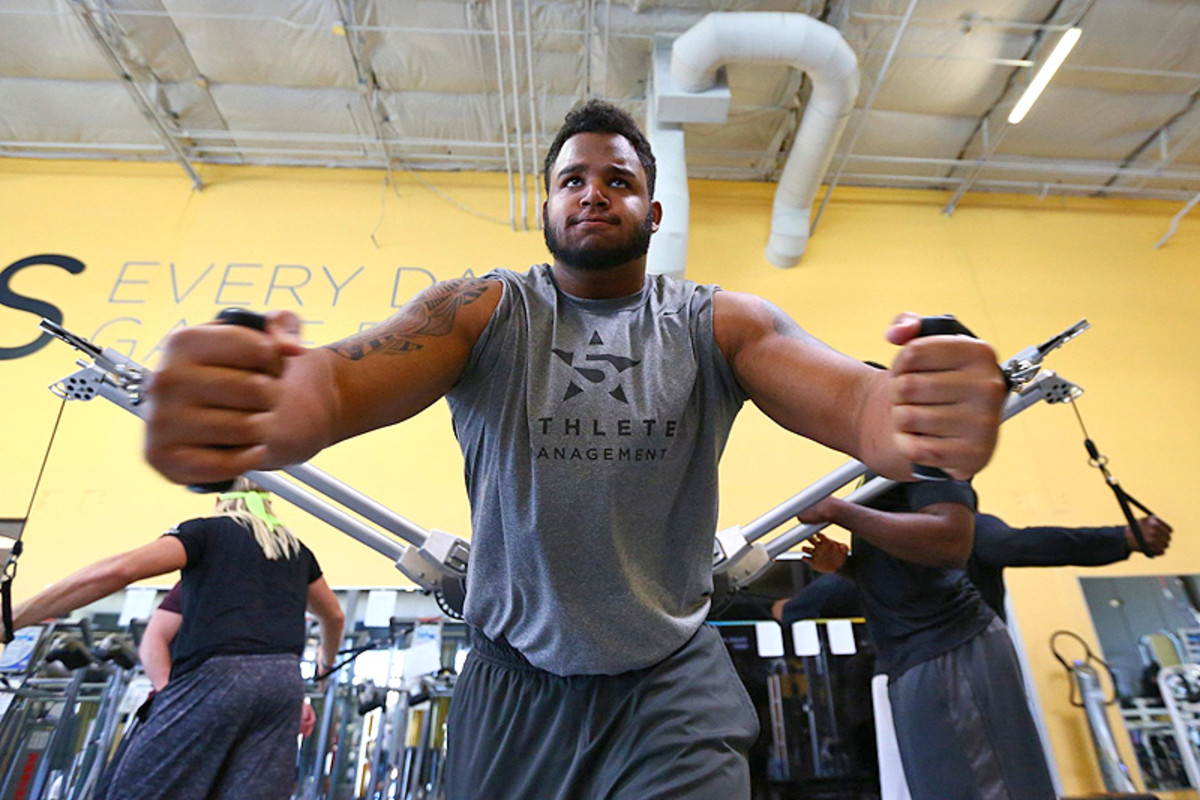
Bennett (middle) warmup for the day's training with Auburn's Gabe Wright (left) and USC's Leonard Williams (right). (Mark J. Rebilas for SI/The MMQB)

Bennett prepped for the three-cone drill. (Mark J. Rebilas for SI/The MMQB)

And the short shuttle. (Mark J. Rebilas for SI/The MMQB)
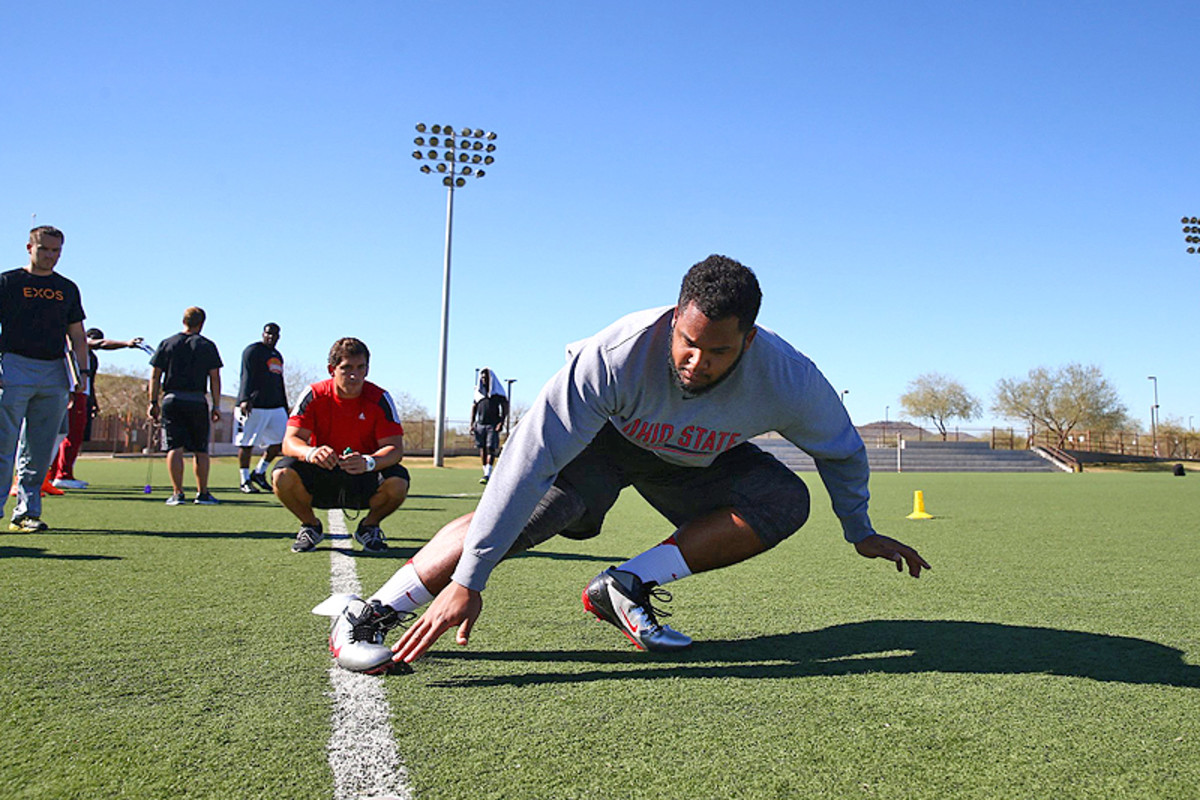
Working the bench press with USC's Leonard Williams. (Mark J. Rebilas for SI/The MMQB)

Bennett (right), Boston College's Seyi Adebayo (middle) and USC's Leonard Williams at the vitamin counter at EXOS. (Mark J. Rebilas for SI/The MMQB)

Bennett's order. (Mark J. Rebilas for SI/The MMQB)
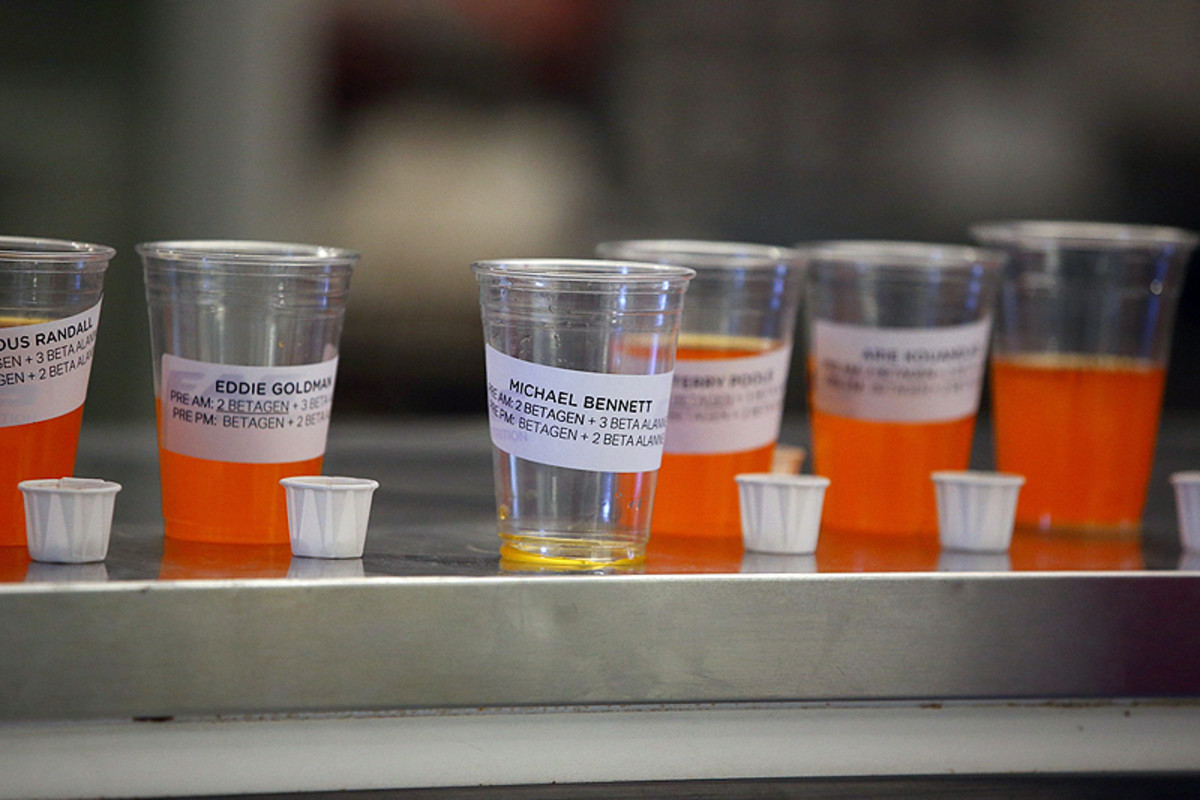
During a break, it was ping-pong with mulleted Nevada prospect Brock Hekking. (Mark J. Rebilas for SI/The MMQB)

* * *
The groin did not heal in time for the combine. While the other defensive linemen jumped and ran and bench-pressed at Lucas Oil Stadium, Bennett watched. He was weighed and measured, and even that was a disappointment. He chugged water to add extra heft, but it passed straight through him. He could not fool the scale: He had gained only one pound since that Feb. 10 weigh‑in.
Bennett did interview with multiple teams, but even that was underwhelming. He was ready for all the screwball questions he’d heard about from former teammates. Colts tackle Jack Mewhort, for instance, had been given a minute to list as many possible uses for a brick as he could. Bennett had his list, but no one asked. “I didn’t get any random questions,” he told his agents in the lobby of the Omni Severin after a day of interviews.
Bennett was asked one thing he found odd. “You’re a guy who has a lot of options,” he recalls a Lions representative saying. “So how do we know you’re really focused on football?” The question seemed to be code for: You grew up comfortably. You have a degree in family financial planning. How do we know you won’t ditch football for some other line of work two years into your rookie contract? This question came almost a month before 24-year-old 49ers linebacker Chris Borland—a rookie in 2014—retired, citing fear of long-term brain injury. Clearly, teams were worried about this possibility before Borland left the sport. Bennett was initially shocked by the question. “It’s almost like a backward compliment,” Bennett says. “You have options, but we don’t want you to have options.” NFL contracts usually include a large up-front investment, so it made sense that teams might want to gauge Bennett’s dedication. “Having a lot of options means I’m smart and I can do different things,” Bennett says. “But I have to reassure teams I’m not a flight risk.”
Bennett hoped his responses were satisfactory, because he knew he couldn’t answer teams’ questions about his speed or agility until his pro day. As darkness fell on Feb. 21, Bennett and his agents began walking toward the Circle Centre Mall in search of dinner. What did Bennett want? “Pizza,” said the man who weighed in seven pounds lighter than he’d hoped.
The Trainee
Bennett and USC's Leonard Williams worked in tandem at EXOS. (Mark J. Rebilas for SI/The MMQB)
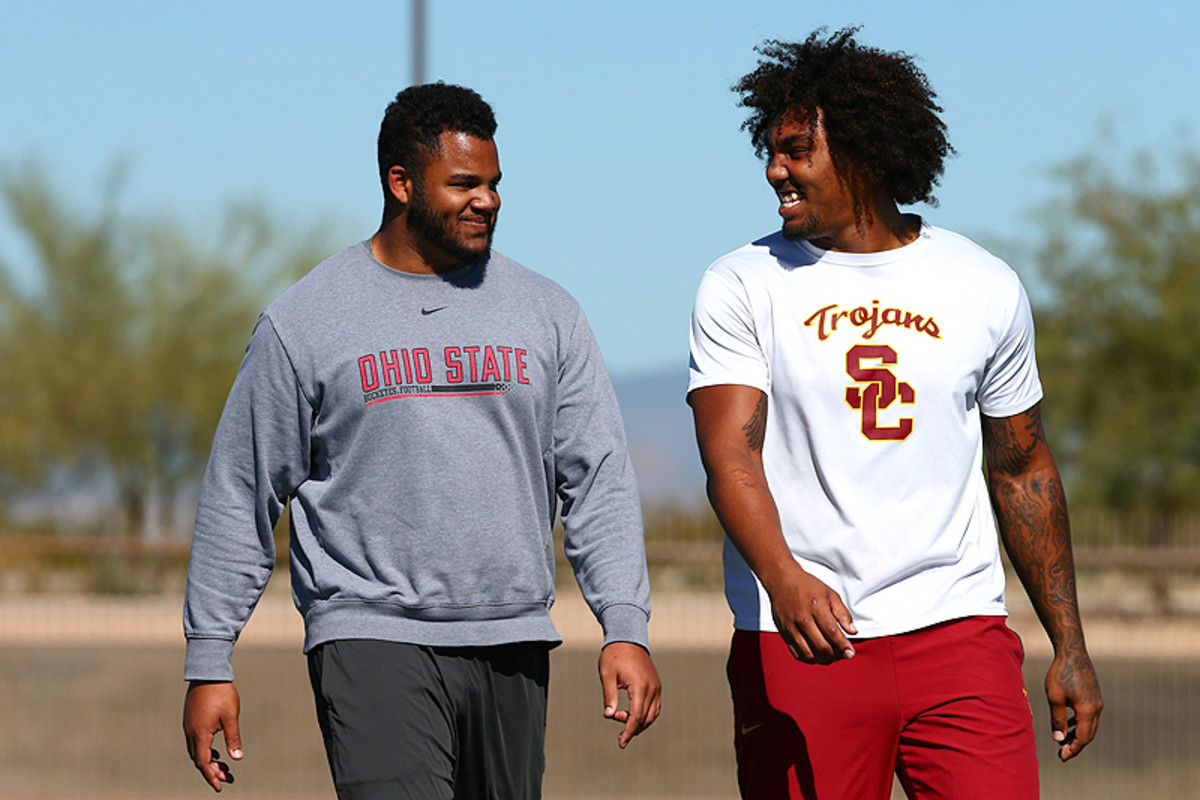
Photo by Mark J. Rebilas for SI/The MMQB

bennett-williams-4.jpg

Photo by Mark J. Rebilas for SI/The MMQB

Photo by Mark J. Rebilas for SI/The MMQB

* * *
Bennett had a definite plan for pro day. He would dazzle with his vertical jump. He would answer any lingering questions with his time in the 40, which he hoped would be around 4.8 seconds. He would perform position drills that would show off his explosiveness. Then he would celebrate by enduring considerable pain. The upper portion of Bennett’s left arm is covered by a tattoo of a huge, snarling bear made more menacing by Bennett’s considerable muscle mass. Why a bear? Because it looks badass. The right arm? Lakers guard Nick (Swaggy P) Young says his right arm is “strictly for buckets”; Bennett’s is strictly for the Buckeyes. Bennett has had all manner of Ohio State imagery inked to that limb, and he wanted to add a national championship trophy to his forearm.
Prospect Breakdowns
Marcus Mariota: Everything but the fireJameis Winston: Is he worth the trouble?Melvin Gordon: Can he break the RB first-round drought?Amari Cooper: Is he worth a top-10 pick?Randy Gregory: The NFL’s next great pass rusher, if...

Seventy-six men came to Ohio State to evaluate the Buckeyes who intended to make football their livelihood. The group featured representatives from all 32 NFL teams, including some key decision makers. Steelers coach Mike Tomlin was there. So were Bengals coach Marvin Lewis and Vikings general manager Rick Spielman, the older brother of former Ohio State linebacker Chris Spielman.
In the weight room Bennett sneaked a peek at the clipboards of some of the team reps. Next to his name, a few had predicted a 4.95-second 40-yard dash. He had to beat that.
The day started perfectly for Bennett. He weighed in at 297 pounds and then reached 33½ inches on the vertical jump, which would have placed him third among defensive tackles at the combine. Those days of carefully calculated calories in Arizona had paid off. He declined to bench-press because of a slightly strained pectoral muscle, but he could always do that later. There is no difference between 225 pounds loaded on an Olympic bar at the combine or in a college weight room or in a training facility. Bennett knew those scouts wanted to see him run the 40 to give them a basis for comparison with the other defensive tackles in the draft. They wouldn’t get the completely controlled conditions and laser timing they had in Indianapolis, but they would see the digits dance on their own stopwatches.
Bennett had only been running full speed for two days, but he didn’t want to wait. “The whole idea was you have to show teams something,” Bennett said. “You can’t just keep putting it off.” Beneath a scarlet banner emblazoned with the words “the grind,” Bennett limbered up on the turf field of OSU’s indoor practice facility. The moment of truth came when Buckeyes strength coach Mickey Marotti put a bullhorn to his lips and broke the silence.
Mi-chael Ben-nett.
Mi-chael Ben-nett.
Bennett took his place at the starting line. He crouched in a sprinter’s stance. Then he blasted forward. In the bleachers Connie and Mike saw their son flying. This 40 would make the wait worthwhile.
Bennett crossed the finish line knowing he had looked fast. “It looked like I was floating,” he says. But floating is less effective than driving—planting deep in the turf to create the explosive propulsion that starts in the thigh, travels down the leg and fires through the ball of the foot. Bennett heard someone mutter, “Five flat.” Five flat wouldn’t prove anything. He had to run again.
He tried to stay loose as former teammates turned in their 40s. But Bennett knew something was wrong. He had gone so long without running full blast that his body hadn’t been prepared for the shock of a wide-open sprint. Marotti raised the bullhorn again.
Mi-chael Ben-nett.
“I knew as I was going back to the line for the second 40 that I was going to pull something,” Bennett recalls. “My calf didn’t feel right, and my quad didn’t feel right. But I wanted to run it because I knew I could go faster.” This time he chose to drive instead of fly.
A few steps from the finish, Bennett felt the pop.
He ignored it. “You can always drive one or two more steps,” Bennett says. After he crossed the line, Bennett grabbed his left hamstring. His grunts were drowned out by the gasp from the crowd. The Ohio State parents knew what was at stake for Bennett. So did his teammates.
But as Bennett cussed his luck and limped back to where his sweats lay in a pile, he paused and asked a scout what his stopwatch read. The number was 4.85.
Some scouts have itchy stopwatch fingers. Some have slower ones. The numbers for that second 40 reported to NFL teams may vary by a few hundreths of a second, but Bennett had definitely run faster. He had improved his time by about the duration of a blink, but that could be one valuable blink. Afterward, Bennett sat in the tattoo artist’s chair. Had he not improved his time, the hamstring might have dominated his thoughts. Instead, only one thought echoed: “I hope this tattoo looks good.”
The Trainee
Though his time improved, Bennett's second attempt at the 40 came at a price. (Jamie Sabau for SI/The MMQB)

Photo by Jamie Sabau for SI/The MMQB
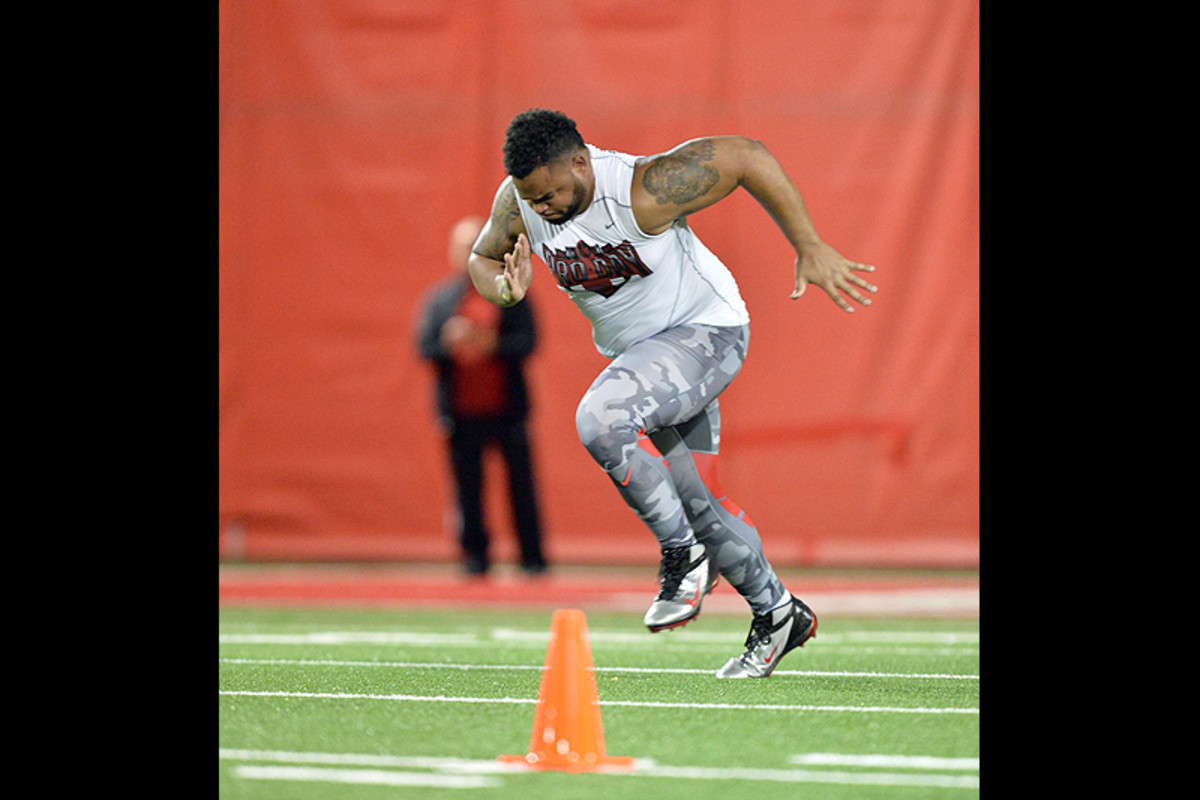
Photo by Jamie Sabau for SI/The MMQB
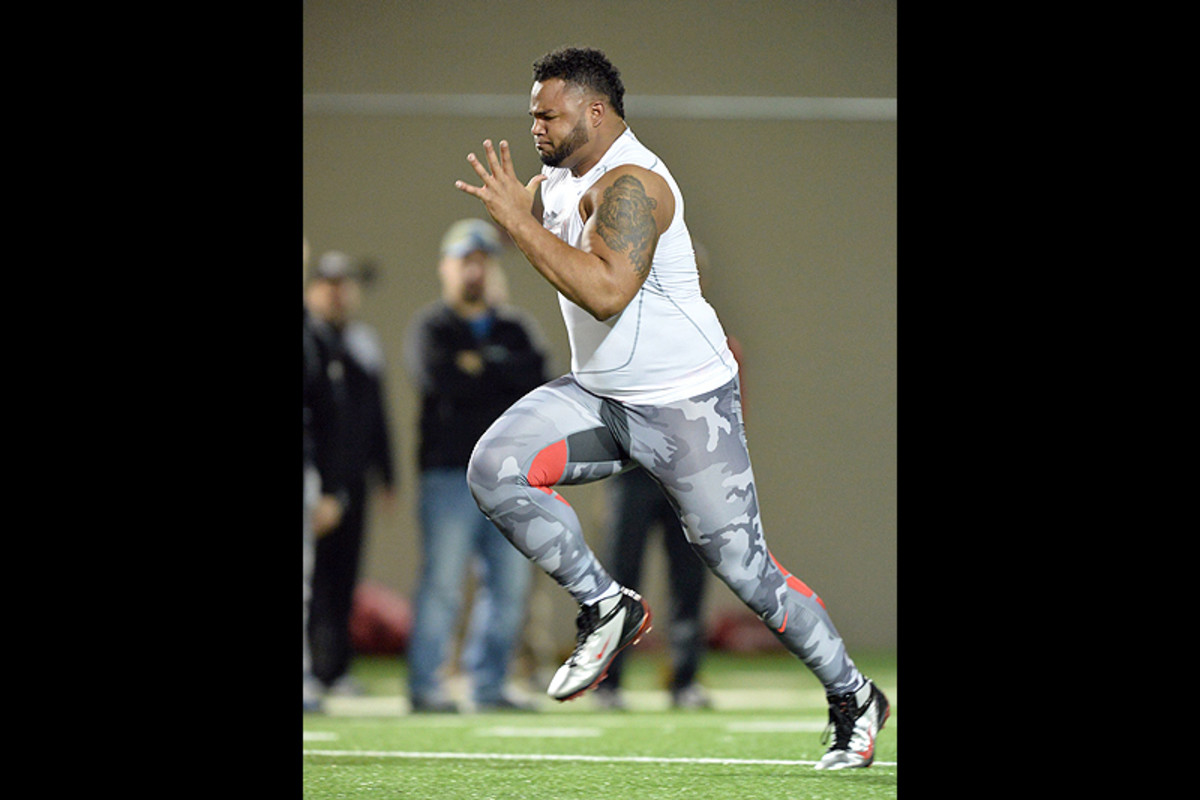
Photo by Jamie Sabau for SI/The MMQB

Photo by Jamie Sabau for SI/The MMQB

* * *
The Art of Picking Late
No pick in the top 10? No problem. Roster architects from two of the NFL’s most consistently successful franchises—Pittsburgh general manager Kevin Colbert and Baltimore assistant GM Eric DeCosta—share insights into their draft-day strategies for picking late in Round 1. FULL STORY

Bennett has spent the time since pro day letting his hamstring heal. He met with the Panthers on March 20, but his only work came on a grease board as he diagnosed plays. Last week, he also met with Jaguars officials. Bennett remains frustrated about this most recent injury for two reasons. “One, it doesn’t look good to come off an injury and immediately get injured—even though that’s kind of expected,” he says. “But two, I felt great. I was moving faster than I had ever moved, and I was 15 or 20 pounds heavier than when I moved that fast before. I just feel like I could have put up ridiculous numbers in all the drills.”
Bennett’s case offers an excellent test for the draft’s version of the nature versus nurture debate. How much does college film matter versus the events in the Underwear Olympics? The answer probably won’t become apparent until the second round begins on May 1. Bennett doesn’t believe he’ll fall further than that. “I put up two years of good film,” he says. “They know what they’re getting.”
If the hamstring feels better, Bennett may try to perform position drills for teams the week before the draft. If the hamstring remains tender, he will have to stand on the numbers he already logged. Ultimately, the most important parts of Bennett’s three-month job interview—that 33½-inch vertical and those two 40-yard dashes—may have been packed into about 11 seconds.
“It’s all about what you do,” Bennett says, “in that little bit of time.”
DRAFT CENTRAL: Complete coverage on The MMQB’s draft hub
Follow The MMQB on Facebook, Twitter and Instagram.
[widget widget_name="SI Newsletter Widget”]
